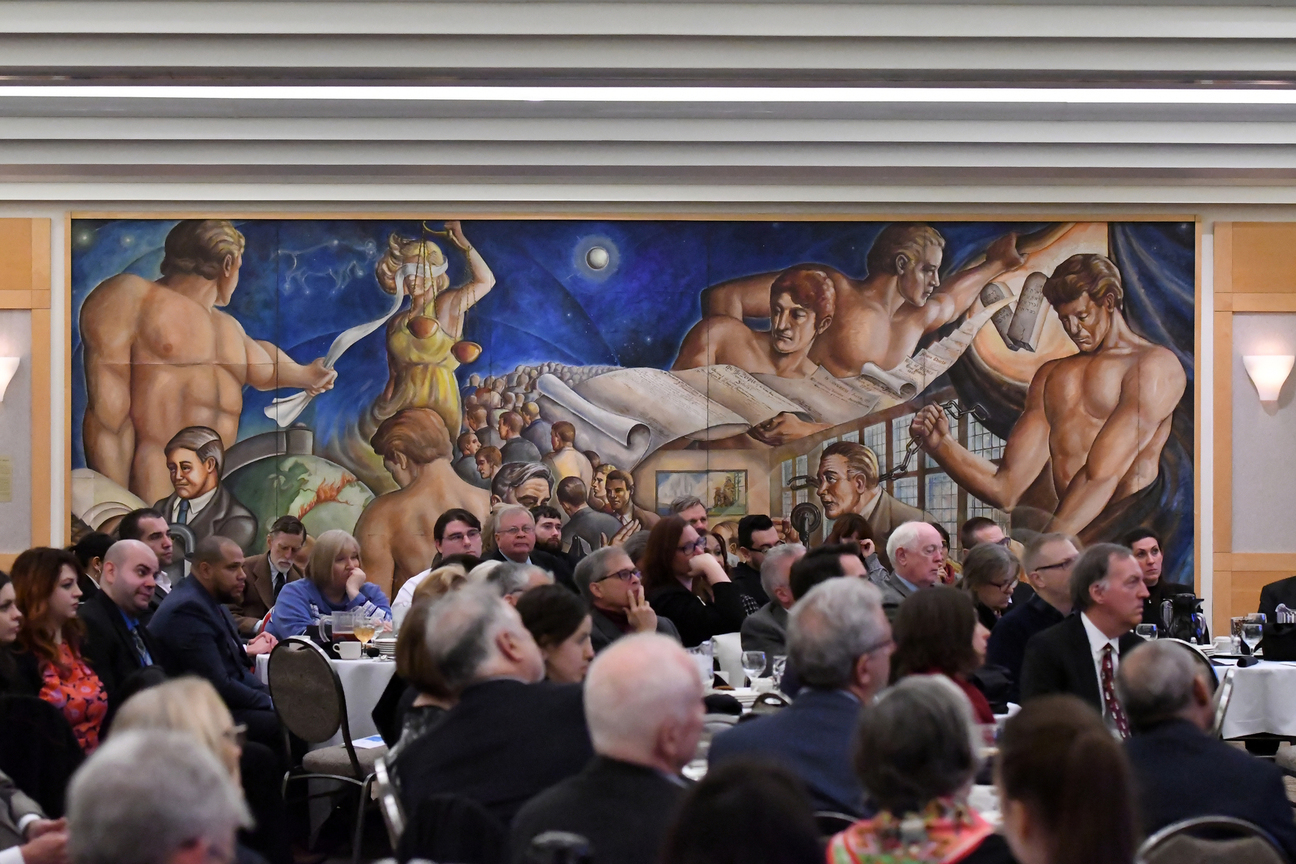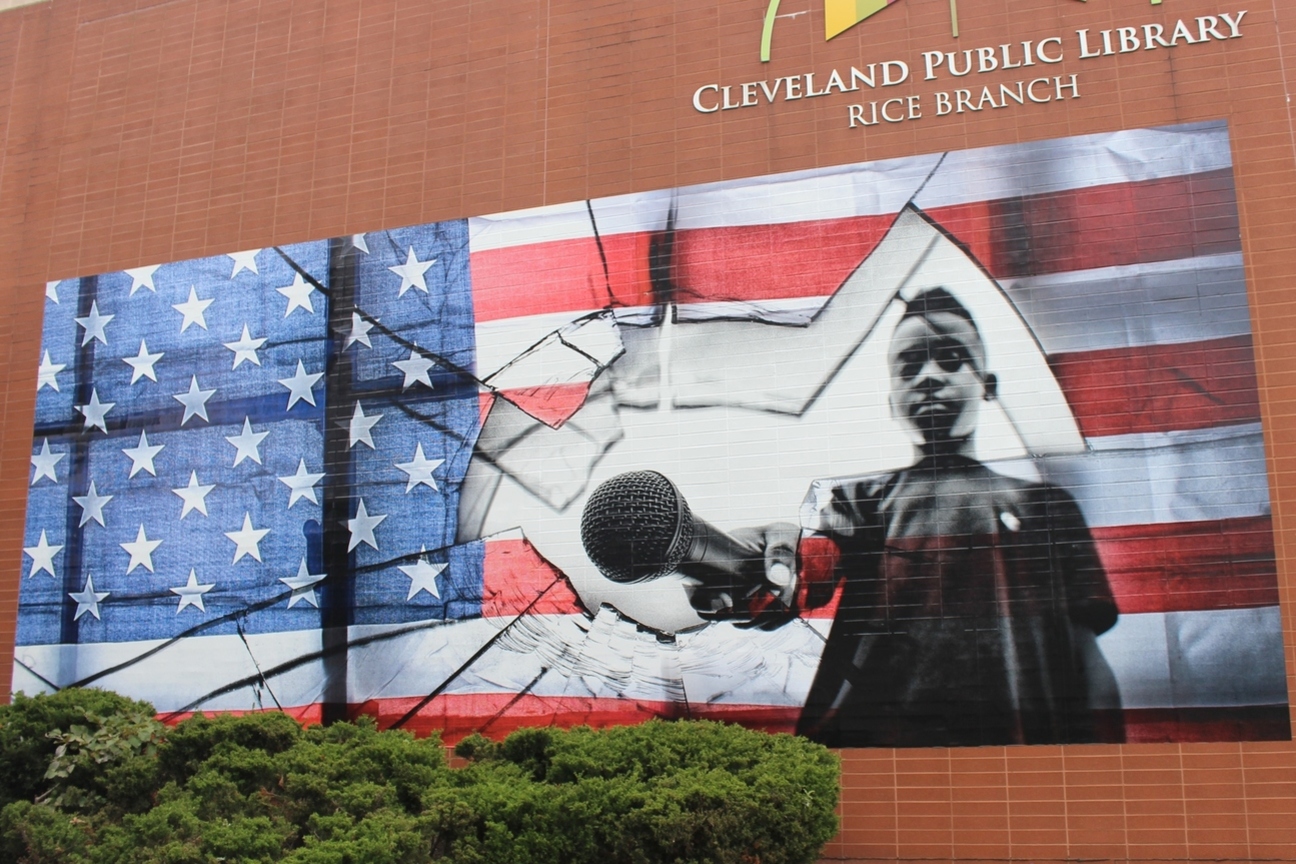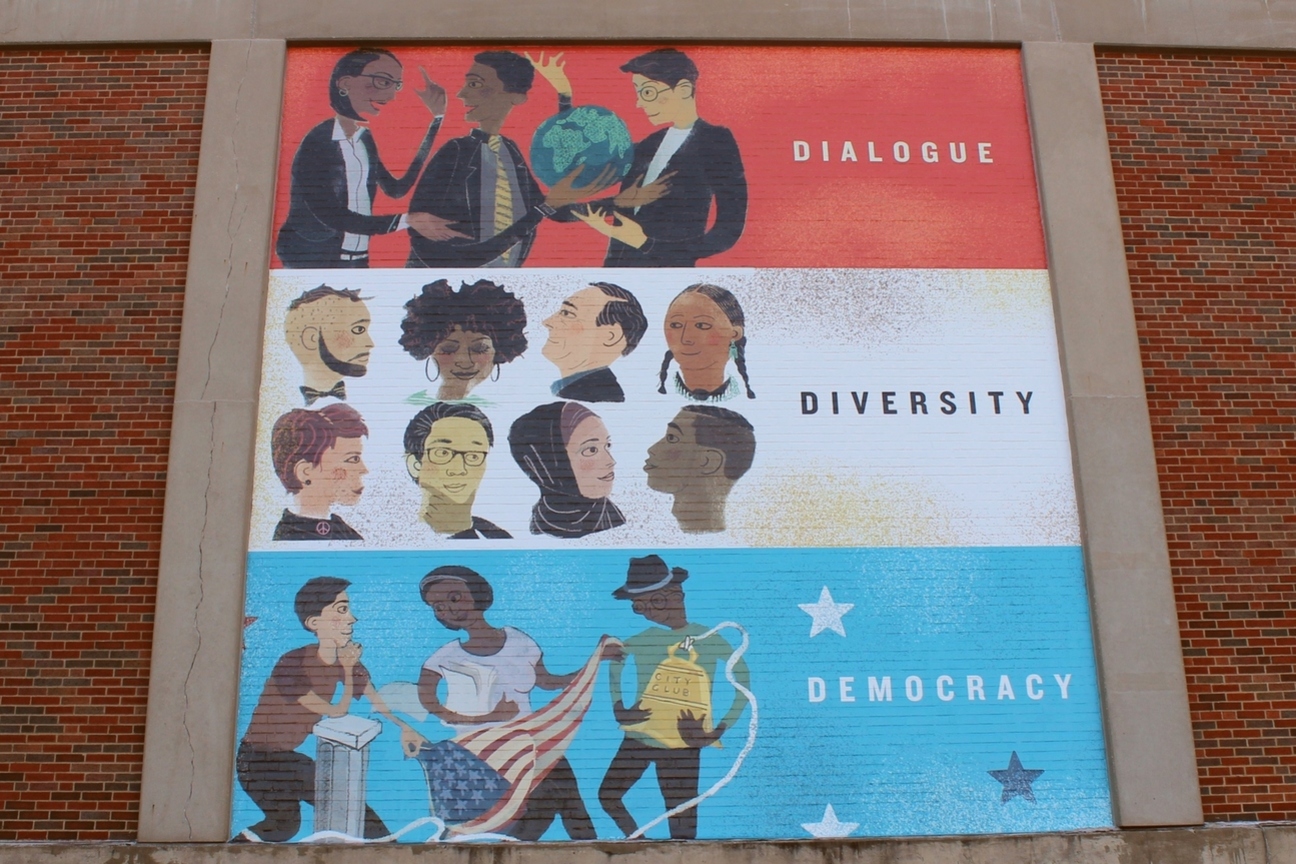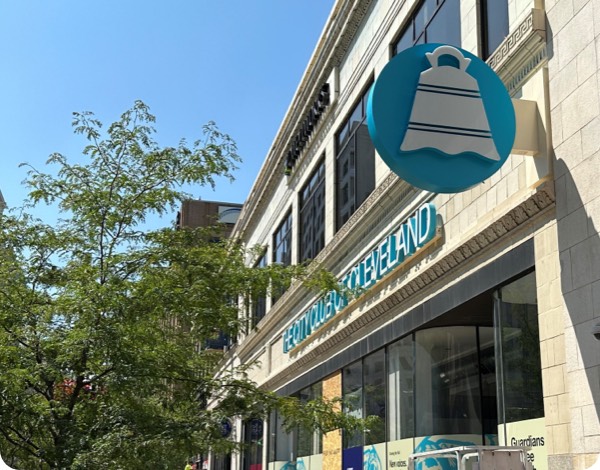
In 2017 the City Club of Cleveland commissioned three murals to be installed around Cleveland to celebrate the 75th anniversary of the original “Freedom of Speech” mural which hangs in the City Club auditorium, seen above. Each local artist in this series was invited to create a mural exploring what freedom of speech means in Cleveland today.
The artists featured in the Freedom of Speech Mural Project are Donald Black Jr. (displayed at the Rice Branch of Cleveland Public Library), April Bleakney (displayed at Bonfoey Gallery, with an additional reproduction now located at the City Club's new location at 1317 Euclid Ave.), and Christopher Darling (displayed at New Tech Collinwood High School).
The Freedom of Speech Mural Project is made possible by a generous grant from the Kulas Foundation with additional support from The Char and Chuck Family Foundation, The Longview Foundation, Joanne Cohen, Morris Wheeler and Family, Cleveland Public Library, and Cleveland Metropolitan School District. Special thanks to LAND studio.

The original mural has been contributed to the collection at the Western Reserve Historical Society and is on display at The Cleveland History Center. For more information The Cleveland History Center website.
About the Mural
A social realist painter, Elmer Brown admired the work of Diego Rivera and other Mexican muralists, emulating their robust treatment of the human figure. Several large, muscular men dominate the painting, giving it energy and strength. The mural tells a story through a series of related images. Tablets bearing the Ten Commandments on the upper right seem to “give birth” to the great documents of freedom; the Magna Carta, the Bill of Rights, the Declaration of Independence and the Constitution. A woman holds the scales of Justice, and a speaker stands by a podium expressing his views. “Like the Mexican muralists, Brown often used tightly composed images to include more narrative,” says Berg.
The Restoration
The mural moved several times over the years as the City Club was forced to find new quarters. After the move to 850 Euclid Avenue in 1981, the mural had to be cut down to accommodate its new space. Sadly, the missing section was lost. The Renovation Committee decided to restore the mural as part of the current renovation, including repainting the missing section. An old photograph of the original mural was used to recreate the missing piece.
A restoration team headed by Gail Berg of Berg and Associates worked for over five months to restore the mural to its current condition. Well-known local artist Gretchen Troibner painted the missing section of the mural, which includes the two men and the lock in the lower left of the painting. Painting conservator Kenneth Be and professional art installer Andy Rock restored and reinforced the fragile masonite panels by attaching wooden planks to the reverse sides. The mural’s panels are installed individually, to make moving easier and safer. During the 2023 move to the Playhouse Square location at 1317 Euclid Avenue, the mural was donated to the Western Reserve Historical Society, where it will be on display at a future date. A smaller, printed reproduction will be on display at the current location.
About the Artist
Elmer W. Brown (1909 – 1977) came to Cleveland at the age of twenty and studied at the Cleveland School (now the Cleveland Institute of Art). He taught at Karamu House, where he befriended writer Langston Hughes, eventually illustrating some of his books. As an employee of the Works Progress Administration (WPA) in the early 1940’s, Brown created a series of murals including “Freedom of Speech,” commissioned for the City Club of Cleveland. Elmer Brown was one of the first African American artists to enjoy critical acclaim from all segments of the community and “Freedom of Speech” has been called the single most important work by a Cleveland-trained black artist. Brown spent the last 18 years of his career working for American Greetings Corporation.

Here, Donald Black Jr., inspired by Brown’s work, uses shattered glass and the American flag to comment on America’s concept of freedom of speech.
Location
Cleveland Public Library - Rice Branch
11535 Shaker Blvd. Cleveland, Ohio 44104
Artist
Donald Black Jr.
Artist Statement
We are taught that we have the freedom to say what we want. Conflict arises when we want to express what we feel and those expressions and thoughts are on the list of things we don’t talk about in this country. As a result, we become trapped in a cycle of generational silence. There is no such thing as true freedom of speech—it’s an illusion, just like the American flag as a symbol of freedom and equity.
In this work, “Your silence will not save you”, the flag represents dysfunctional and unfair systems. The shattered glass is a symbol of breaking the cycle of dysfunction, silence, and injustice. Freedom is not as solid as we project it to be. It is delicate, and like glass, it can be broken. It is time to break the silence and offer the microphone to Black people. This is the only way to free our individual and collective voices.
Read more about the artist here

Here, April Bleakney, inspired by Brown’s work, features a young woman as the central figure in her modern depiction of free speech.
Location
Bonfoey Gallery
1710 Euclid Ave. Cleveland, Ohio 44115
Artist
April Bleakney
Artist Statement
The themes of Elmer Brown’s original Freedom of Speech mural of “breaking ties to oppression and exclusion, while compelling viewers and attendees at forum events to ask questions, avoid making assumptions, and keep learning” are as important now as they were in 1942; I’d argue especially so in our current political climate. The opportunity to visually celebrate these concepts, promote the City Club, and the citizens of Cleveland greatly appeals to me.
I wanted this mural to embody the spirit of Brown’s work, but updated for our present time and, hopefully, for our future. One issue with the original mural I notice immediately is the absence of women and people of color. The central figure in my design was consciously chosen to be a young woman. As expression is at the core of free speech, my mural incorporates this quality of expression visually with a variety of expressive mark making techniques (brushes, drips, washes that are then translated into screen printing). My hope is to create something colorful, expressive, and vibrant - visualizing not only our citizens but visually abstracting community and concepts such as exchange, voicing, listening, learning, building, and engaging.
Read more about the artist here

Here, Christopher Darling, inspired by the sequential nature of cave paintings and comic books, focuses on three key words “dialogue, diversity, democracy” and, using a color palette and symbols from Elmer Brown’s original mural, presents a series of stories of democracy in action, even painting himself into the picture.
Location
New Tech Collinwood High School
Cleveland Metropolitan School District
15210 St. Clair Ave. Cleveland, Ohio 44110
Artist
Christopher Darling
Artist Statement
Inspired by Neolithic Period cave drawings and current graphic novels, I decided to take a sequential and narrative approach to this mural. By drawing color from the original Elmer Brown mural and incorporating shades of the lake and city parks, I’ve developed a palette at looks both contemporary and nostalgic for the turn of the century.
The story is told in three parts. First is dialogue—the foundation of the City Club’s work. The burning earth from Brown’s original mural is restored and Elmer Brown takes center stage in this story. The second story is intended to reflect Cleveland’s great diversity and the importance of engaging people of all ages, races, and genders to bring their voices to the conversation in order to strengthen our democracy. The final story is more metaphorical. Democracy is the bedrock of our country, symbolized with a pillar, our flag, and a liberty bell, and I placed myself in the bottom as a participant in democracy. The woman in the center is holding documents representing the rules, regulations, and institutions of the past that are falling into obscurity to make way for a new, bright future.
Are you a guardian of free speech?
A gift to support our Guardians of Free Speech Campaign will ensure the growth of civil, civic dialogue for generations to come.
Upcoming forums
We create conversations of consequence to help democracy thrive. Here's who is speaking next at the City Club. Be challenged. Learn something new. Join us.
You love free speech. Join the club.
Check out membership benefits and become a member today!
1317 Euclid Avenue, Suite 100
Cleveland, Ohio 44115

1 of 22